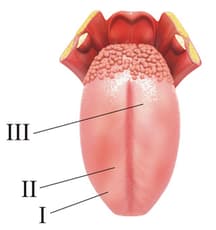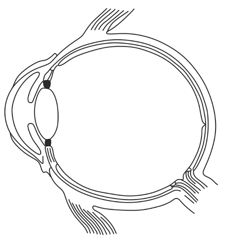The A leaves the eye and the retinal blood vessels enter it at a point medial to and slightly above the posterior pole of the eyeball. B is not present in that region and hence it is called the C . At the posterior pole of the eye lateral to the C , there is a yellowish pigmented spot called D with a central pit called the E .
| A | B | C | D | E |
| Optic nerves | Photoreceptor cells | fovea | macula lutea | blind spot |
| A | B | C | D | E |
| Optic nerves | Photoreceptor cells | macula lutea | blind spot | fovea |
| A | B | C | D | E |
| Optic nerves | Photoreceptor cells | blind spot | macula lutea | fovea |
| A | B | C | D | E |
| Optic nerves | Photoreceptor cells | blind spot | fovea | macula lutea |
Important Questions on Nervous system and Sense Organs
State the main functions of the following:
Tears.
Study the following diagram of human tongue and identify the part I, II, and III

Which statement is CORRECT regarding blind spot in human eye?
It ___________.
Write one function of lens of the human eyeball.
Write one function of Iris of the human eyeball.
Redraw the picture given below. Identify the name indicated and label the parts

The part refracts light rays into the eye.
Give biological explanations for the following:
We should not put sharp objects into our ears
Mention the exact location of the following
Incus.
Choose between the two options to answer the question specified in the brackets for the following.
An example is illustrated below.
Example: Corolla or Calyx (Which is the miter whorl?) Answer: Calyx
Sclerotic layer or choroid layer (Which one forms the iris?)
Choose between the two options to answer the question specified in the brackets for the following.
An example is illustrated below.
Example: Corolla or Calyx (Which is the miter whorl?) Answer: Calyx
Perilymph or endolymph (Which one surrounds the organ of Corti?)
Answer the following questions briefly:
Explain how the human eye adapts itself to bright light and dim light.

